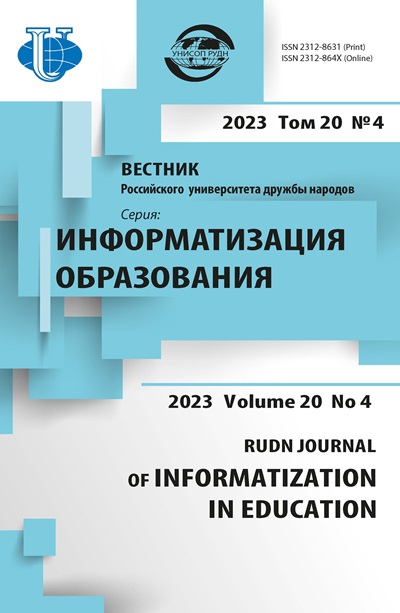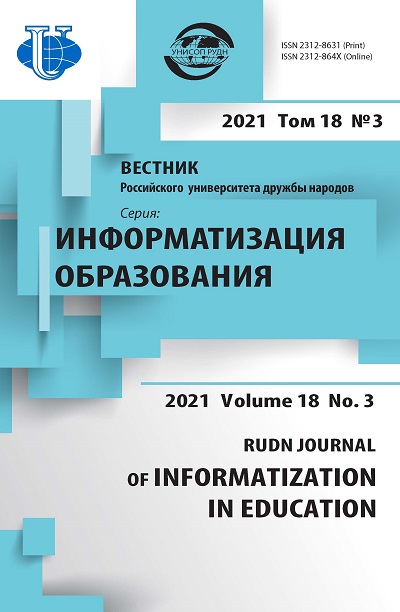Choosing a project topic by students in the development and implementation of it projects
- Authors: Ruzhnikov M.S.1, Charnaya O.M.2
-
Affiliations:
- School No. 1552
- School No. 1363
- Issue: Vol 18, No 3 (2021)
- Pages: 258-271
- Section: CURRICULUM DEVELOPMENT AND COURSE DESIGN
- URL: https://journals.rudn.ru/informatization-education/article/view/29966
- DOI: https://doi.org/10.22363/2312-8631-2021-18-3-258-271
Cite item
Full Text
Abstract
Problem and goal. The theoretical approaches and main stages of work from the point of view of design thinking, as well as the experience of choosing topics and developing IT projects by students in grades 10-11, are presented. Methodology. The methodological basis of the work was the analysis of the design thinking method, which is presented in the works of R. Kyudale, O. Kempkens, G. Andreev, A.S. Krotova and A.A. Barkov. Approaches to the use of the design thinking method in the development of an IT project by a schoolchild are formulated, their brief characteristics and the tools used are given. As tools of the design thinking method at different stages of project development, the following are used: analysis of existing solutions, similar situations, insights from opinion leaders, analysis of artifacts, interviews, swot analysis, five “Why?”, the method of focal objects, scamper, etc. Results. In the process of working on the project, students in grades 10-11 use the tools of design thinking in their activities. The result of the work is an IT project of students “Smart Pomodoro Timer”. Conclusion. In order to introduce the method of design thinking into the joint work of a teacher and a student on an IT project into practice, it is necessary to develop a system of advanced training for teachers in terms of developing practical skills in using design thinking tools for effective process management. In addition, develop the creative potential of teachers and students in the context of the digital transformation of education and attract specialists from different fields (designers, software developers, data analysts, etc.).
About the authors
Michael S. Ruzhnikov
School No. 1552
Author for correspondence.
Email: ruzhnikov@mail.ru
teacher of computer science
25 Musy Dzhalilya St, Moscow, 115580, Russian FederationOlga M. Charnaya
School No. 1363
Email: olga-charka@yandex.ru
teacher of computer science
82 Ryazanskiy Prospekt, bldg 4, Moscow, 109444, Russian FederationReferences
- Kotova NS, Mitusova OA, Gelpey EA. “Design Thinking” as a new approach to teaching management in master’s degree. Uchenye Zapiski. 2018;(3): 47–51. (In Russ.) http://dx.doi.org/10.22394/2079-1690-2018-1-3-47-51.
- Altukhova NF, Vasilyeva EV. The practice of applying design thinking techniques in the course “Internet Entrepreneurship”: from idea creation to prototyping. Finance: Theory and Practice. 2017;(3):194–201. (In Russ.) Available from: https://cyberleninka.ru/article/n/praktika-primeneniya-tehnik-dizayn-myshleniya-v-kurse-internet-predprinimatelstvo-ot-sozdaniya-idei-do-prototipirovaniya (accessed: 01.12.2020).
- Strahovich EV. Application of the design thinking method in teaching IT project management. Software Engineering: Methods and Technologies for the Development of Information and Computing Systems (PIIVS-2018): Collection of Scientific Papers of the Faculty of Computer Science and Technology of Donetsk National Technical University. Donetsk; 2018. p. 20–25. (In Russ.)
- Maksimova SM, Pulyavina NS. Design thinking in organizing students’ project work. Russian Journal of Entrepreneurship. 2018;19(4):1323–1330. (In Russ.) http://dx.doi.org/10.18334/rp.19.4.3899
- Krotova AS, Barkova AA. Design – thinking as a means of developing students’ creativity. International Scientific Review. 2016;(4(14)):195–197. (In Russ.) Available from: https://cyberleninka.ru/article/n/dizayn-myshlenie-kak-sredstvo-razvitiya-kreativnosti-uchaschihsya (accessed: 01.12.2020).
- Van Ya, Kathanova YuF. Formation of design thinking in school teaching practice. Teacher XXI century. 2019;(3–1):178–185. (In Russ.) Available from: https://cyberleninka.ru/article/n/formirovanie-dizaynerskogo-myshleniya-v-shkolnoy-praktike-obucheniya (accessed: 01.12.2020).
- Elfimova TA, Dulsky EYu, Ivanova MV. Pulling model of teaching in the system of additional education for children. Pedagogical Ideas: Modern Technologies for Modern Education: Materials of the All-Russian Scientific and Practical Conference. Kazan: Buk Ltd; 2020. p. 18–23. (In Russ.)
- Mueller-Roterberg C. Handbook of design thinking. 2018.
- Kempkens O. Design thinking. All tools in one book. Moscow: Eksmo Publ., 2019. p. 16–17. (In Russ.)
- Andreev G. Design thinking. Designing the future. Moscow: De’Libri; 2020. (In Russ.)
- Braun T. Design thinking in business: from new product development to business model design. Moscow: Mann, Ivanov i Ferber Publ.; 2018. (In Russ.)
- Gvozdenko YuV, Ishchenko AA, Pilipenko AV. Development of design thinking of schoolchildren in the analysis of the results of educational achievements. European Student Scientific Journal. 2019;(3):54. (In Russ.)
- Holina SA, Popova AV. Using the project management method in extracurricular activities in physics. Bulletin of the MSRU. Series: Pedagogics. 2018;(1):91–98. (In Russ.) http://dx.doi.org/10.18384/2310-7219-2018-1-91-98
- Mesyac VA, Shemyakina EYu. Using the methodology “Map of Empathy” for solving educational, research and some production problems. Modern Education: Content, Technology, Quality. 2019;1:397–399. (In Russ.)
- Vasilyeva EV. Research of customer experience on the basis of design thinking tools in the course “Internet Marketing”. Modern Information Technologies and IT Education: Collection of Scientific Papers of the II International Scientific Conference and the XII International Scientific and Practical Conference. Moscow: Laboratoriya Otkrytyh Informacionnyh Tekhnologij Fakul'teta VMK MGU imeni M.V. Lomonosova; 2017. p. 171–179. (In Russ.)
- Doody O., Noonan M. Preparing and conducting interviews to collect data. Nurse Researcher. 2013;20(5):28–32.
- Bogomolova VG. SWOT analysis: theory and practice of application. Economic Analysis: Theory and Practice. 2004;(17):57–60. (In Russ.) Available from: https://cyberleninka.ru/article/n/swot-analiz-teoriya-i-praktika-primeneniya (accessed: 03.12.2020).
- Price RA, Wrigley C, Staker K. Not just what they want, but why they want it: traditional market research to deep customer insights. Qualitative Market Research. 2015;18(2):230–248.
- Filippov MYu. Using the method of focal objects for the development of schoolchildren’s creativity in digital learning. Pedagogy, Psychology, Society: Development Prospects. 2020. p. 133–137. (In Russ.)
- Kuznetsova NP, Grigorieva PA. Application of the method of focal objects. Modern Conditions of Interaction Between Science and Technology. 2017. p. 66. (In Russ.)
- Vasileva EV. A little about the approach and a lot about the tools for developing creative thinking, exploring client requests and generating ideas (How to understand customers and create rewarding experiences in the experience economy?). Moscow: RUSAJNS Publ.; 2018. (In Russ.)
- Saginova OV, Zavyalova NB, Saginov YuL. The influence of the research activity of a university teacher on the effectiveness and quality of teaching: problem statement based on the analysis of scientific literature. Human Capital and Professional Education. 2013;(4):4–7.
- Warfel TZ. Prototyping: a practitioner’s guide. New York, NY: Rosenfeld Media; 2009.
- Tschimmel K. Design thinking as an effective toolkit for innovation. ISPIM Conference Proceedings. The International Society for Professional Innovation Management (ISPIM); 2012. p. 1.
- Ruzhnikov MS, Agafonov VM, Dulskij EYu. Development of 4K-competencies in the classroom of the children’s technopark “Quantorium Baikal”. New Information Technologies in Education and Science: Materials of the XI International Scientific and Practical Conference. Ekaterinburg: Ros. gos. prof.-ped. un-t Publ.; 2019. (In Russ.)
- Anohina NF. Study of the factors of school failure from the standpoint of time management. School Technologies. 2015;(5):85–90. (In Russ.) Available from: https://cyberleninka.ru/article/n/issledovanie-faktorov-shkolnoy-neuspevaemosti-s-pozitsiy-taym-menedzhmenta (accessed: 01.12.2020).
- Chemerilova IA, Ivanova EK. The use of time management technology in the formation of self-organization skills in younger students. MNKO. 2019;(1(74)):253–255. (In Russ.) Available from: https://cyberleninka.ru/article/n/ispolzovanie-tehnologii-taym-menedzhmenta-v-formirovanii-umeniy-samoorganizatsii-u-mladshih-shkolnikov (accessed: 01.12.2020).
- Geel J. van. Pitching ideas: make people fall in love with your ideas. Moscow: Mann, Ivanov i Ferber Publ.; 2019. p. 58. (In Russ.)
- Vasina OV. Elements of TRIZ-pedagogy in physics lessons. Problems of Pedagogy. 2017;(1(24)):45–52. (In Russ.)
- Dulsky EYu, Ivanov PYu, Gladkov AA, Ruzhnikov MS. Program-methodical case – the basis of a modern educational-methodical complex in educational activities. Problems and ways of development of vocational education: Collection of Articles of the All-Russian Scientific and Methodological Conference. Irkutsk: Irkutskij Gosudarstvennyj Universitet Putej Soobshcheniya; 2019. p. 118–122. (In Russ.)
- Mohapatra BN et al. Smart performance of virtual simulation experiments through Arduino Tinkercad Circuits. Perspectives in Communication, Embedded-Systems and Signal-Processing-PiCES. 2020;4(7):157–160.
















